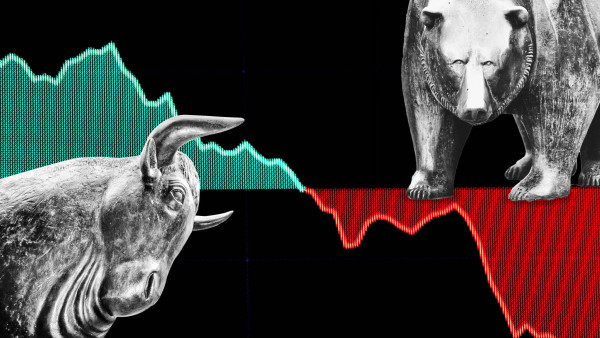

History is helpful in thinking about what could happen in future, and the behaviour of UK inflation from 1870-2019 revealed three insights.
First, monetary policy matters. Inflation was lower and more stable when monetary policy was explicitly linked to inflation, from gold standards, to Bretton Woods to the era of independent central banks with inflation targets.
Second, high inflation was not frequent or long lasting. You were four times more likely to experience inflation of less than 5 per cent a year than more than 5 per cent a year.
Third, it is rare to move from a low to high inflation period, occurring 14 per cent of the time. A lot had to change for this to happen, such as major wars and changes in monetary policy frameworks.
For the past decade until 2021 we were in a low inflation regime. The rolling three-year average for CPI was between 1 per cent and 3 per cent, with peak inflation rates of just over 5 per cent in September 2008 and September 2011.
The conclusion from the historical study is that we need to see a lot of changes before we assume that we are moving to a high inflation era, given that high inflation is unusual and big changes in inflation regimes infrequent.
Will inflation stay high?
At 10 per cent, inflation is high today and predicted to rise further over the next 12 months, peaking at 13 per cent using Bank of England baseline projections. What matters for investors is whether inflation remains high over multi-year time horizons.
Most of the rise in UK inflation has come from record gas prices, higher food prices and rising goods prices. Each in turn has been driven by increased demand and/or reduced supply.
Demand in general is expected to weaken in response to rising interest rates, rising taxes, reduced government spending and the effects on wealth of falling share and bond prices.
How quickly and by how much demand slows depends on how events unfold and governments respond to them, including support on energy and heating and interest rate rises.
Supply is much harder to predict than demand because of the complexity of supply chains, the uncertainty surrounding the Russia/Ukraine war and potential for more extreme weather conditions.
The Russian invasion of Ukraine has led to the significant cut in gas supplies to Europe, which has pushed up prices 10 fold versus peak pre-pandemic levels.
Longer term, the responses to high gas prices are sowing the seeds for increased investment in non-gas energy sources as well as less energy use, which will put downward pressure on energy prices over time.
The Ukraine invasion has also reduced the global supply of wheat, cooking oils and other key commodities, impacting overall food prices. Droughts and floods have also reduced food supply. War and extreme weather conditions mean a wider range of potential outcomes.
What has improved are the bottlenecks that reduced manufacturing activity in 2020 and 2021. Fewer lockdowns and less pressure on shipping and distribution is evident in measures such as the New York Fed Global Supply Chain Pressure Index. If these trends continue, it will remove a major driver of higher goods prices.
On balance, demand and supply factors are acting to bring inflation down in years to come. There are many wildcards that make the range of outcomes wider than usual, including the evolution of the Russia/Ukraine war, changes in global supply chains, technological advances and acts of nature from pandemics to droughts and floods.
Dealing with uncertainty
Uncertainty about the inflation outlook means that it is risky to build a portfolio that performs well only in a specific inflation scenario. In fact relying on any specific economic or market forecast is risky, given the poor track record of professional forecasters, the complexity of the global economy and the randomness of shocks.
Here are three ways to deal with uncertainty in a more reliable way.
Firstly, consider a range of feasible scenarios over a full economic cycle when assessing how much to pay for an asset. Assets that already reflect a feasible worst-case scenario are more likely to withstand adverse conditions.
They are also more likely to generate higher returns than those that already reflect the feasible best-case scenario. This means undervalued assets stand a better chance of outpacing inflation because their return is more likely to be higher than other assets in most scenarios.
Secondly, search far and wide to identify as many opportunities as possible by getting as granular as possible when researching markets. This increases the chances of identifying different opportunities that are less correlated to other equity, bond and currency markets.
Thirdly, use scenario analysis to identify effective diversifiers by assessing the conditions under which a portfolio of attractive opportunities might perform poorly and from this assess diversifying assets including currencies.
Following this approach led us to buy heavily into assets with inflation-hedging characteristics such as energy shares in 2020, when these were pricing in very low inflation outcomes. They do not point to buying these assets today because their prices reflect much higher inflation expectations.
Portfolio positioning
High inflation is now priced in to a much greater degree in inflation-sensitive assets like energy companies and inflation-linked bonds, making them less attractive as sources of return and diversification.
Instead of seeking to hedge inflation risk directly, investors can search widely for assets that offer the best value and hence higher potential returns. The scope for higher returns provides a buffer in terms of inflation rising further or staying higher for longer.
Diversifiers based on scenario analysis are chosen to improve the robustness of portfolio outcomes, so they are not overly reliant or overly exposed to a specific economic and market environment.
In our multi-asset portfolios we favour UK, Chinese, German and Latin American equities and emerging market bonds from a return perspective, balanced with consumer staples, healthcare companies, high-quality shorter-dated bonds, and safe haven currencies.
Investors are better served by focusing on long-term outcomes, bottom-up market opportunities and multiple sources of diversification rather than relying upon highly uncertain inflation forecasts and assets that already reflect current high levels of inflation.
Mike Coop is chief investment officer, EMEA at Morningstar
All references to inflation are sourced from Morningstar and based on ONS data.



